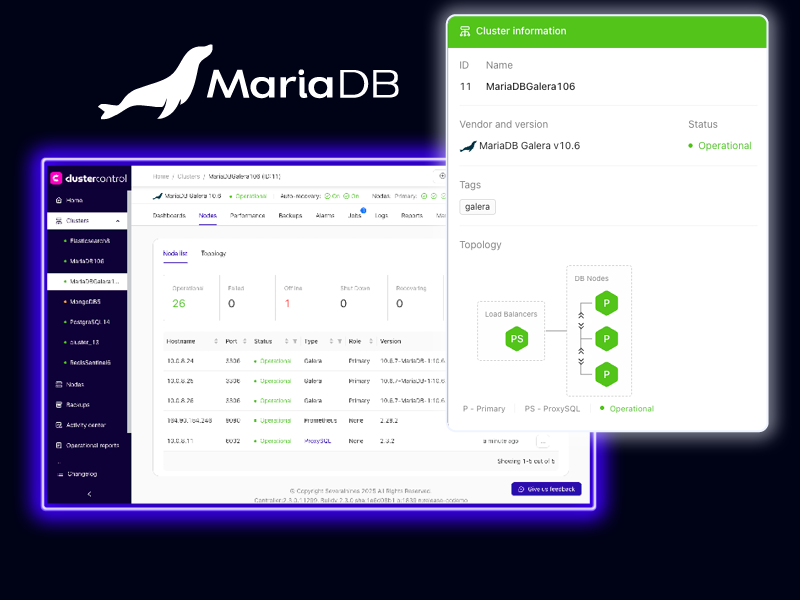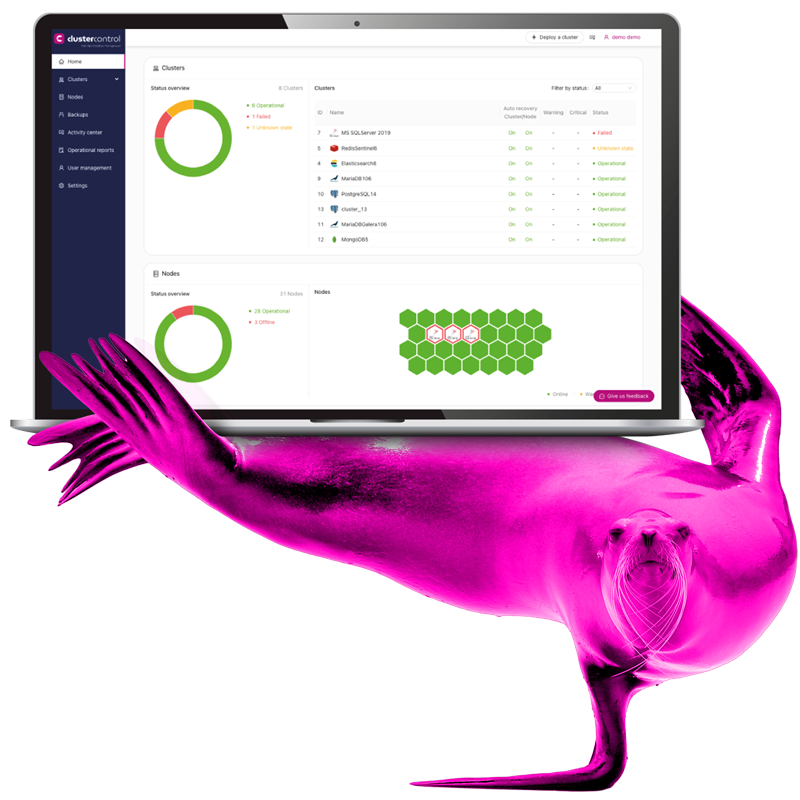Unlock More with ClusterControl + MariaDB
Deploy MariaDB in One Click
Provision standalone, primary-replica or Galera clusters instantly — preconfigured for high availability, scale, and operational control.
Backups with Point-in-Time Recovery
Schedule full, incremental, or partial backups with encryption and compression. Restore across environments or to any point in time (PITR).
Monitor Queries and Replication
Track slow queries, server health, and replication lag with real-time dashboards and built-in advisors to surface bottlenecks automatically.
Scale with Replication Automation
Easily add MariaDB replica or Galera nodes — ClusterControl handles replication setup.
Built-In Enterprise Security
Secure access with RBAC, LDAP, and TLS. Get full audit logging to meet compliance needs—all from a self-hosted platform with no vendor lock-in.
Auto Failover and Recovery
Recover from failure fast with intelligent failover and node recovery for Galera or replication-based topologies.
ClusterControl vs. the Alternatives
ClusterControl is a MariaDB cluster manager built for engineers and trusted by enterprises.
| Feature | ClusterControl | PMM + Orchestrator |
|---|---|---|
| On-prem & hybrid deployment support | X | |
| Automated cluster scaling & topology changes | X | |
| Full operational control | X | |
| End-to-end lifecycle automation | X | |
| Advanced observability & unified dashboards | Limited |
Still Managing MariaDB by Hand? Time to Upgrade.
ClusterControl is the MariaDB management platform DevOps teams actually want. Built for engineers. Trusted by enterprises. Made for your infrastructure.
Having ClusterControl to monitor and alert on our database instances allows us to concentrate on other tasks and duties with the confidence that we will get notified promptly when necessary. The intuitive GUI gives us a unified view of our environment, dramatically simplifying administration and incident response.
Supported MariaDB Configurations
Supported Distributions
Choose from leading MariaDB distributions and deployment sources to match your performance and compliance needs:
- MariaDB Community Server – Open-source distribution maintained by the MariaDB Foundation, fully compatible with MySQL standards.
- MariaDB Enterprise Server – Enterprise-grade distribution from MariaDB Corporation with long-term support, advanced security, and performance enhancements.
ClusterControl also supports installations using official MariaDB repositories, operating system package managers (e.g., APT, YUM), or custom repository binaries — giving you ultimate flexibility.
Replication & High Availability
Ensure resilient and scalable MariaDB deployments with production-ready replication and HA technologies:
MariaDB Galera Cluster – Native synchronous multi-primary replication for strong consistency, automatic failover, and high availability across nodes.
Asynchronous Replication – Commonly used and lightweight; ideal for read scaling and simple failover.
Semi-Synchronous Replication – Provides stronger data protection by confirming writes on at least one replica before committing.
Severalnines is Enterprise Ready

Reliable
Zero-downtime operations you can count on.

Secure
Data stays protected, at rest and in transit.

Compliant
GDPR, SOC 2, ISO27001 standards.
Managed MariaDB features list
| Licenses | |
| Open Source | |
| Cluster management | |
| Deploy / import cluster | |
| Add / duplicate / remove / decommission node | |
| High availability | |
| Load balancer | |
| Automated failover | |
| Asynchronous / synchronous replication | |
| Backup / restore | |
| Full / incremental / partial backups | |
| Backup compression / encryption | |
| Point in Time Recovery (PITR) | |
| Local / cloud backups | |
| Observability | |
| Infrastructure / database / query monitoring | |
| Dashboarding / alerting | |
| Security / compliance | |
| Role-based access control | |
| Key management | |
| LDAP integration | |
| TLS encryption | |
| Reporting | |
| Audit log |
Choose the CC plan that fits your use case and preferred payment terms
Advanced
self-serve
Includes all features from Advanced
- Deploy 2 to 5 node clusters
- Monthly subscription
- Pay with Credit Card
- Community support
starts at€250per node, per month
€0.35per node, per hour
Advanced
Includes everything from Community
- Load balancers
- Scaling and failover
- Backup and recovery
- Monitoring and alerting
- Database user management
- Business hours support
Custom pricing
Enterprise
Includes everything from Advanced
- CC Ops Centre
- Backup verification
- Ops reports and audit logs
- RBAC & LDAP / Active Directory
- Key management, TLS encryption
- Web / email / phone 24×7 support
Custom pricing
Want some CC for MariaDB information for later?
Top rated Docs
MariaDB and MySQL are sometimes misnamed and considered the same. How does ClusterControl deal with each?
Each deployment and processing of each technology is specific to each. Documentation may refer to both where there are common areas but are specific where it applies, e.g., backup tooling.
If I have MySQL but want to deploy MariaDB and use things like MaxScale, XtraDB, OQGRAPH, and SPIDER, do you cover that migration?
ClusterControl will deploy the MariaDB version you desire, from 10.3 to 10.11, so, as with any database migration, you will only have to import the data into the deployed MariaDB.
Can I import an existing MariaDB environment and then create a Spider sharding from that?
Yes, just take a look at how that’s done here.



